ARTICLES AND INSIGHTS
Characteristics of towns in the Tokyo Bay (WANGAN) Area (Part 2)
*Click here for (Part 1), which shows the summary of each town in the Tokyo Bay area.
Towns in the Tokyo Bay (WANGAN) area have developed independently from each other, and further changes are expected to take place there in the future. Among them, the impact of the Tokyo Olympics is significant. In addition, large-scale development projects have been seen in areas where there had previously been no movement. Let us look at the future of the Tokyo Bay area.
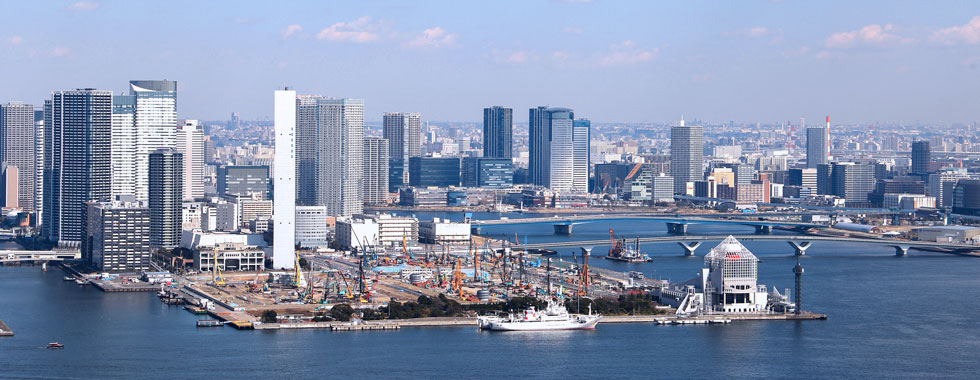
Harumi is not the only town that will change due to the Tokyo Olympics games.
For the Tokyo Olympic games, venues for tennis, triathlon, fencing, and other sports are planned to be constructed in Ariake while the athletes’ village is scheduled to be built in Harumi. Among them, what has been a big focus in relation to housing is the athletes’ village, which will be subdivided and rented by the private sector after the Tokyo Olympic games. We hear that, under the current plan, approximately 6,000 units in a total of 25 buildings, including two super-high-rise apartment buildings and a commercial building, which are planned to be constructed after the end of the Olympic games, will be supplied.
Because they account for around 30% of all the new apartments that are supplied in the 23 wards of Tokyo in a year, some people express concern over, or point out problems related to, demand-supply balance, prices, and other elements. However, it is certain that the residential population will increase in the Tokyo Bay area. This will be welcomed if it leads to benefits such as an increase in facilities for convenience of life, including commercial facilities, and improvement in the convenience of the immediate area.
Another town where changes are expected to take place in relation to the Tokyo Olympic games is Kachidoki. Construction of the Circular Road 2 has been suspended because the plan to relocate the Tsukiji market has been frozen. If this road is completed, however, it will take only around five minutes by car to travel between Kachidoki and Toranomon. This represents a significant improvement in convenience, which may cause changes in the areas around Toyomi, the warehouse district on the west side, not to mention Kachidoki.
“Rio de Janeiro and London, which hosted Olympic Games in recent years, achieved significant economic development after the Games were over. I hope that Tokyo will also achieve such development. We also hope that the Tokyo Bay area will attract attention after the Olympics, leveraged by venues of the sports and other elements.” (Mr. Takaaki Tanabe, manager of Wangan Branch, Ken Corporation.)
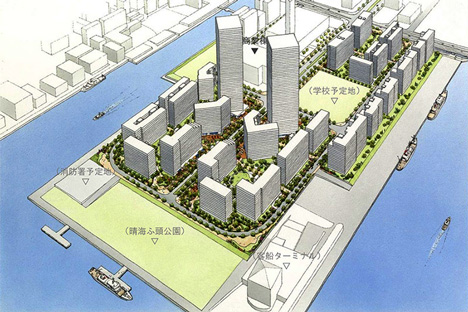
A plan to construct a triple tower in Ariake with slightly more than 1,500 units
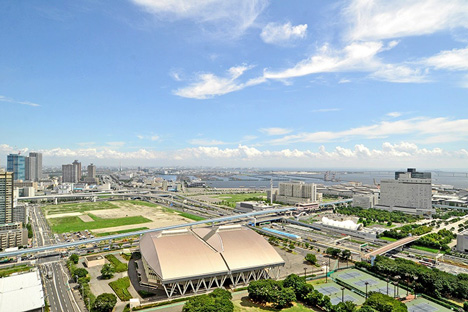
The largest-scale development project planned in this town is the Tokyo Bay Triple Tower Project (tentative name), a project to construct three buildings with 33 above-ground floors each in the land adjacent to Ariake Tennis Park, which is scheduled to be completed in the spring of 2020. In addition to slightly more than 1,500 units of dwelling for sale, childcare facilities, shops, and other facilities are planned to be attracted to the site. There is also a plan to construct a large-scale commercial facility, a hotel and event hall, parking area, and other facilities in the lots facing the housing construction site. It will take a while before the overall project is completed, which is planned for 2026. It is clear, however, that this project will result in a significant change in the landscape.
“Ariake only has one supermarket and a few convenience stores. Residents have to walk to the area around Tokyo Big Sight to eat at a restaurant. If facilities including a large-scale commercial facility are constructed in this town, convenience will be improved significantly and the overall town will be seen in a new light.” (Mr. Tanabe)
“Promising large properties include the Park Tower Harumi, which is to be completed in Harumi in 2019, and the Shibaura 2-chome Project that is planned to be completed in 2022. In Chuo-ku, there is increasing momentum toward development of the east side in response to the relocation of Tsukiji market. In Minato, which is a short distance away, Park City Chuo Minato The Tower is scheduled to be completed in the winter of 2017. Construction is also under way in four to five sites in Tsukishima in relation to disaster control. However, many of the properties being constructed there are smaller in scale than existing ones. (Mr. Tanabe)
The high popularity of KACHIDOKI THE TOWER, into which residents began to move in January 2017, should also be mentioned here although it is not an upcoming project. Probably reflecting high expectations for the first new residential building in Kachidoki in eight years since THE TOKYO TOWERS, there is a flood of applications for 200 units for rent among the 1,420 units in total.
“More than half of those who viewed the inside of the tower apply, which is beyond expectations.” (Mr. Tanabe)
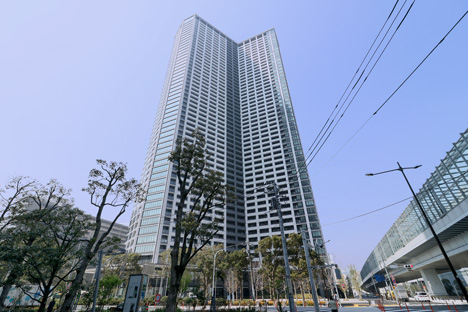
Attention should also be paid to Okawabata River City 21, which was subleased by UR to the private sector.
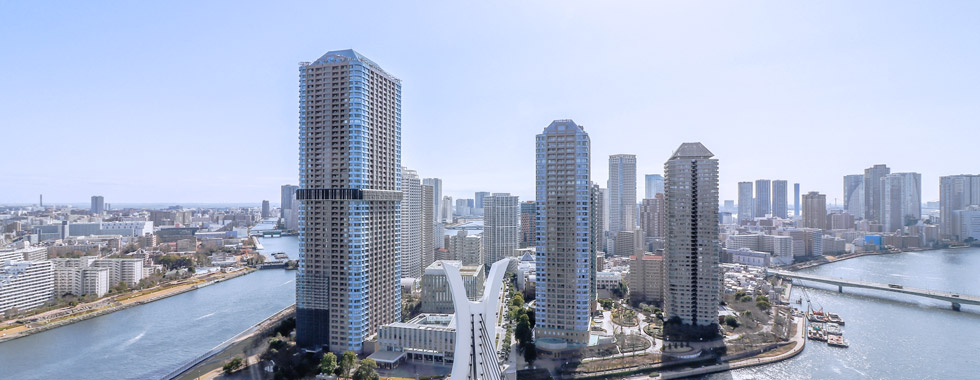
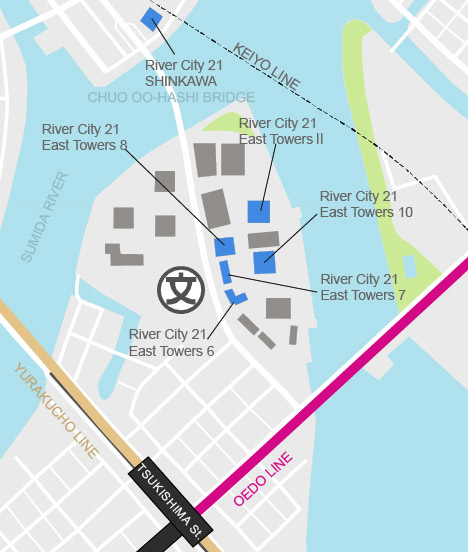
Another big focus in the Tokyo Bay area is the redevelopment of the Okawabata River City 21 (hereafter, “River City 21”) . The River City 21 is a project for redeveloping the old factory site of Ishikawajima-Harima Heavy Industries Co., Ltd. (now IHI Corporation) in Tsukuda, which began in 1988 to encourage a return of people to the center of Tokyo.
This project was implemented by the Housing and Urban Development Corporation, which is now the Urban Renaissance Agency (UR), the Tokyo Metropolitan Government Bureau of Housing, Tokyo Metropolitan Housing Supply Corporation, and Mitsui Fudosan Co., Ltd. It was redeveloped as a large-scale residential district including eight towers. While the buildings differ slightly from each other in height and design, the unified overall exterior view has earned high marks. The landscape including the Sumida River, cherry blossoms, and super-high-rise buildings could be mentioned as one of the representative landscapes of the center of Tokyo. Its contrast with the historical townscape of Tsukuda is also perfect for a picture.
Among the buildings in the River City 21, the East Towers (four buildings including one tower), East Towers II, and River City 21 Shinkawa on the opposite shore, which are owned by UR, were subleased to the private sector in October 2016. This is a project for leaving the management of approximately 13,000 units of expensive rented accommodations in the center of Tokyo that are owned by UR, one by one, to private business operators in accordance with the Basic Policy on Reform of the Incorporated Administrative Agencies, a cabinet decision that was made in 2013. The project has slowly made progress since 2015. River City 21 is the greatest ever both in scale and location.
“They boast a location that is 10-minute bus ride from Tokyo Station, a pathway with a row of cherry blossom trees commanding the view of the Sumida River, the spacy site, and view of a mature town. They also feature a rich variety of distinctive room plans, including a unit whose ceiling is as high as four meters and a unit with a dependence that permits two families to live close to each other. However, they had been forgotten because of the lack of sufficient public relations activities. Overall, there are about 300 vacant units. To increase the occupancy rate first, we began to offer them with lower rents compared to the days when they were owned by UR.” (Mr. Tanabe)
He said that rents of some units were reduced by 1,000 yen or 2,000 yen per tsubo (3.3 square meters) and units whose rents have been decreased by 20,000 yen to 30,000 yen, which is highly beneficial for people interested in renting them. Because nothing is left to be desired about their location and environment, they will attract attention again if appropriate renovations and equipment replacement are enabled by the increase in the occupancy rate. Because I have been observing the property since it was built, I would be very happy if its attractiveness is rediscovered. Above all, you will definitely be attracted to it if you visit the site in the season of cherry blossoms.
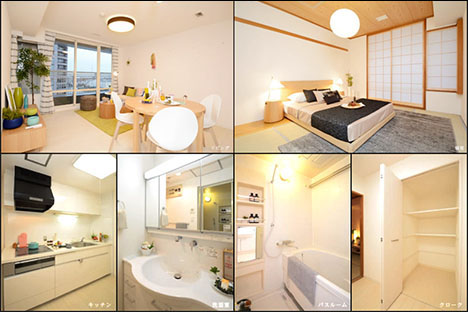
Hiroko Nakagawa
For more than two decades, Nakagawa has been involved in editing magazines, books and websites on living-related issues such as purchasing, leasing and building. Nakagawa has lived in Omotesando for many years, and is keenly aware of the comfort of living in central Tokyo. Nakagawa is the author of an All About Guidebook titled Sumiyasui Machierabi: Shutoken (Finding a livable town: Tokyo metropolitan area).
Need help? Please contact us.
Our English-speaking agents can help in your search for properties, provide suggestions about real estates values and utilization.
